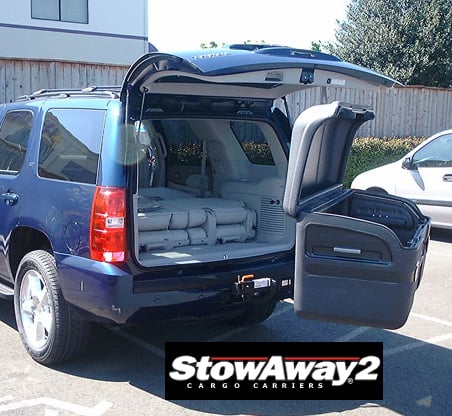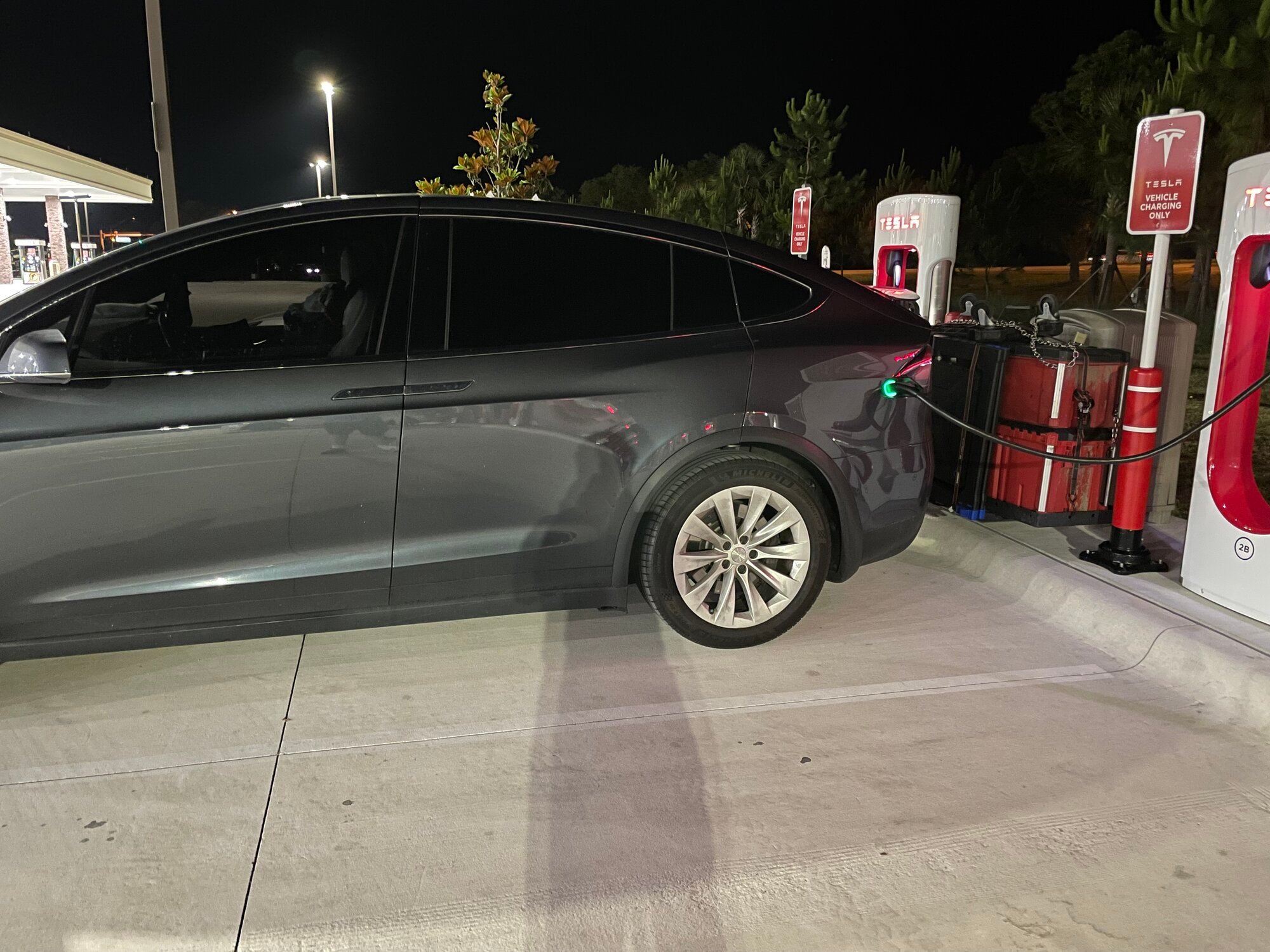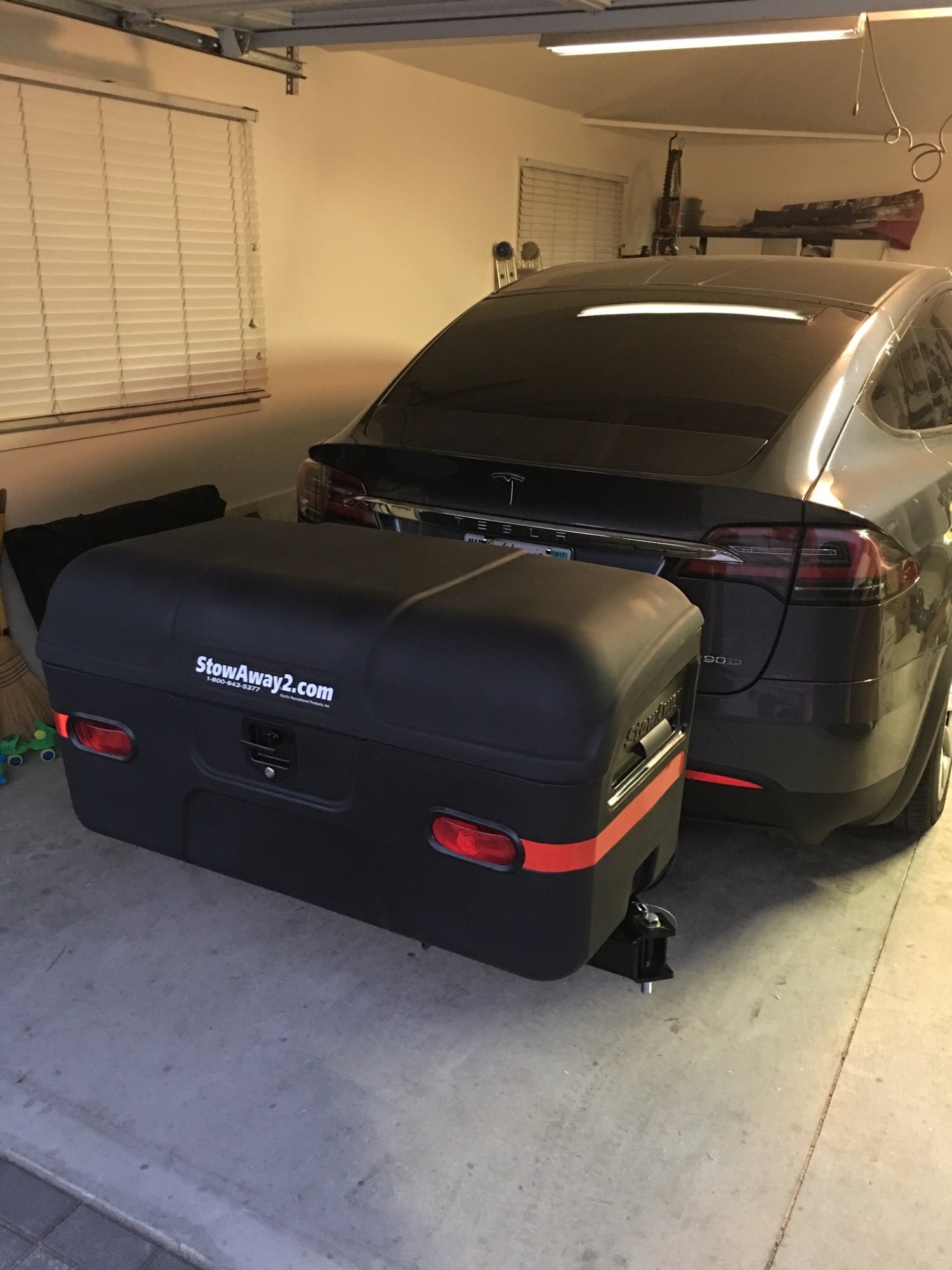I have a question : I have the accessory hitch installed as I was planning to carry at least 3 bikes with the Tesla/Yakima rear bike carrier. The problem is I didn't know the hitch would only support 120 lbs and the bike rack itself weighs 40-44lbs. That makes only 76-80 lbs left for the bikes themselves. It is not enough. My bikes - all combined - are up to 91 lbs, which means my cargo is 11-15 lbs over. Do you think is it serious/dangerous ?
Welcome to Tesla Motors Club
Discuss Tesla's Model S, Model 3, Model X, Model Y, Cybertruck, Roadster and More.
Register
Install the app
How to install the app on iOS
You can install our site as a web app on your iOS device by utilizing the Add to Home Screen feature in Safari. Please see this thread for more details on this.
Note: This feature may not be available in some browsers.
-
Want to remove ads? Register an account and login to see fewer ads, and become a Supporting Member to remove almost all ads.
You are using an out of date browser. It may not display this or other websites correctly.
You should upgrade or use an alternative browser.
You should upgrade or use an alternative browser.
bjm
Member
A recent post on the Tesla forum recounted a trip in a Model X with a 1-UP USA bike rack with 4 bikes. The rack alone for 4 bikes weighs 96 lbs. That doesn't leave much for 4 bikes! He estimated that his rack and bikes weighed 180-190 lbs. Apparently there were no issues, however, I did correspond with Bosal to find out about the rationale for the 120 lb weight limit. As you can see from the reply below, it is based on static testing and dynamic fatigue testing. So, it would seem most reasonable to abide by the recommendation.
"The Tesla Model X hitch is rated at 5000 lbs. GTW (gross trailer weight) with 500 lbs. TW (tongue weight). This is with the 20-inch wheels. With the 22 inch wheel option, the hitch rating drops to 3500 lbs. GTW/300 lbs. TW.
However for carrying bikes, it is only rated for 120 lbs., (55kg) or 2 bicycles.
This is because the loads are different when carrying vs. towing. Towing weight is supported also by the trailer suspension and wheels. Bikes and cargo are unsprung weight, supported only by the tow hitch and vehicle frame.
These ratings were requested by Tesla and determined by exhaustive US SAE (static) testing and EU CARLOS ECE R55 (dynamic fatigue) testing.
I would strongly advise against exceeding these load ratings. For further information, the customer should contact Tesla."
"The Tesla Model X hitch is rated at 5000 lbs. GTW (gross trailer weight) with 500 lbs. TW (tongue weight). This is with the 20-inch wheels. With the 22 inch wheel option, the hitch rating drops to 3500 lbs. GTW/300 lbs. TW.
However for carrying bikes, it is only rated for 120 lbs., (55kg) or 2 bicycles.
This is because the loads are different when carrying vs. towing. Towing weight is supported also by the trailer suspension and wheels. Bikes and cargo are unsprung weight, supported only by the tow hitch and vehicle frame.
These ratings were requested by Tesla and determined by exhaustive US SAE (static) testing and EU CARLOS ECE R55 (dynamic fatigue) testing.
I would strongly advise against exceeding these load ratings. For further information, the customer should contact Tesla."
Thank you very much for your reply bjm. I am a little disappointed as the 2 bikes only is a serious limitation in my opinion. Does anyone know about another bike rack (reminder : I have the Tesla/Yakima 2'') that would be lighter and would allow the carrying of a 3rd (and maybe 4th) bike ?
goneskiian
Active Member
At this point it appears there is no difference between the AH option and the full TP hardware. I would not worry about carrying 4 bikes on the Yakima/Tesla bike rack. It, and the vehicle, can handle it no problem.
I didn't get to talk to them but I saw an X a couple weeks ago at the Ellensburg Supercharger (WA state) with 4 bikes on a 1UP USA rack. Granted a couple of them were pretty nice carbon fiber road bikes most definitely weighing less than 20lbs.
Cheers!
I didn't get to talk to them but I saw an X a couple weeks ago at the Ellensburg Supercharger (WA state) with 4 bikes on a 1UP USA rack. Granted a couple of them were pretty nice carbon fiber road bikes most definitely weighing less than 20lbs.
Cheers!
MTOman
Member
How about 4 fat tire bikes? I just got one that weighs 50 lbs!  Two of those plus the rack itself would exceed the 120 lbs weight limit..
Two of those plus the rack itself would exceed the 120 lbs weight limit..
DriverOne
Member
So if we use a cargo carrier like the Pro Series Rambler, the trailer + cargo limit is 120lbs? I hadn't seen that documented until now.
That carrier is 60lbs by itself! A weather-proof bag is another 9lbs. Which doesn't leave a lot for cargo! (Maybe I need to switch to an aluminum carrier.)
That carrier is 60lbs by itself! A weather-proof bag is another 9lbs. Which doesn't leave a lot for cargo! (Maybe I need to switch to an aluminum carrier.)
I've got a Model X coming in May/ June '18. We camp a lot, bring extra kids and bikes along etc, and I think getting our gear and 2-3 bikes on board while transporting 6+ people is going to be a challenge. With no rooftop box, that hitch is going to be key, so I am already spending way too much time thinking about how to optimize it.
I understand the key issue that makes the recommended weight limit of 120 lbs for hitch carriers less than the rated tongue weight for trailers is the dynamic torques. When you have a long lever arm such as a bike rack or cargo carrier and go over a bump, the torque on the hitch receiver could be considerable. If one could reduce this torque, it should be possible to increase the loads that can be safely carried. Tactic #1 is just to keep the center of mass of the carrier as close to the hitch receiver as possible. Another tactic, though, would be to set up a pre-loaded counter-torque, such as a tensioned strap running from the top of the bikes/ cargo box to an attachment point higher up on the back of the X. This will not reduce the amount of static weight the hitch is carrying, but it would reduce the torque exerted on it.
The question is, where to attach to the back of the X? The spoiler is tempting and perfectly positioned but may be too fragile. I'm not sure if anything could hook on to the indentation you grab to open the trunk. I don't think I'll be welding on a big hook or drilling any holes either, or my kids will disown me. Has anyone else considered this strategy/ broken a spoiler mount/ made any other grievous mistakes/ come up with a brilliant solution you'd like to share?
I understand the key issue that makes the recommended weight limit of 120 lbs for hitch carriers less than the rated tongue weight for trailers is the dynamic torques. When you have a long lever arm such as a bike rack or cargo carrier and go over a bump, the torque on the hitch receiver could be considerable. If one could reduce this torque, it should be possible to increase the loads that can be safely carried. Tactic #1 is just to keep the center of mass of the carrier as close to the hitch receiver as possible. Another tactic, though, would be to set up a pre-loaded counter-torque, such as a tensioned strap running from the top of the bikes/ cargo box to an attachment point higher up on the back of the X. This will not reduce the amount of static weight the hitch is carrying, but it would reduce the torque exerted on it.
The question is, where to attach to the back of the X? The spoiler is tempting and perfectly positioned but may be too fragile. I'm not sure if anything could hook on to the indentation you grab to open the trunk. I don't think I'll be welding on a big hook or drilling any holes either, or my kids will disown me. Has anyone else considered this strategy/ broken a spoiler mount/ made any other grievous mistakes/ come up with a brilliant solution you'd like to share?
Yinn
Active Member
All the Model X's got the same hitch parts, so accessory or tow doesn't matter from a hardware perspective. It matters from a software perspective. SAE testing usually has requirements for a specific load over time and has built in tolerances. So could you technically exceed it w/o encountering issues? Yes. But based on their testing the failure rates exceed their threshold for approval. So is it recommended? No.
There's lighter aluminum based carriers, but they get expensive. A lot of people probably don't want to hear this; but I just tow my loads. I've purchased a trailer and gotten really used to hooking it up quickly. Does it feel silly to show up in a trailer for a Christmas tree? Yes... Or showing up to a park and unloading bikes? Yes... But eventually you get used to perception of it and realize just how much easier a trailer is over a roof rack.
There's lighter aluminum based carriers, but they get expensive. A lot of people probably don't want to hear this; but I just tow my loads. I've purchased a trailer and gotten really used to hooking it up quickly. Does it feel silly to show up in a trailer for a Christmas tree? Yes... Or showing up to a park and unloading bikes? Yes... But eventually you get used to perception of it and realize just how much easier a trailer is over a roof rack.
Thanks Yinn. I've also wondered about just using a small trailer. I think the hit on range would be larger with this than with a hitch carrier, though, since you have extra wheels as well as drag. We'll be driving our X from California to Wyoming and back so range matters. Any experience with battery life when towing a utility trailer - what % hit do you take at highway speeds?
Yinn
Active Member
Thanks Yinn. I've also wondered about just using a small trailer. I think the hit on range would be larger with this than with a hitch carrier, though, since you have extra wheels as well as drag. We'll be driving our X from California to Wyoming and back so range matters. Any experience with battery life when towing a utility trailer - what % hit do you take at highway speeds?
I've towed a utility trailer as well as an enclosed by this point. In my experience I get better mileage with the enclosed, which admittedly was a bit of a surprise to me as a first time tower. The range hit touches upon everything that normally affects us.
Speed and temperature are the major factors, but either way there is a range hit. For highway speeds...
Best case scenario; towing an enclosed trailer with 20" wheels netted me the same range as not towing with 22" wheels. ~10% in my case.
Worst case scenario; was towing an open trailer in single digit temperatures and it consumed ~150% more energy.
Now...I acknowledge this all sounds like an unreasonable amount of consumption on paper. But I also have to say a lot of this is just getting used to it. My first couple of times I had severe range anxiety (75D) - just like when I first bought my Tesla. After having done it regularly; I don't really give it another thought. I just hook up and go and find SC's along the way.
No issues…that you know of…yet…3 e-bikes about 230 lbs total...no issues on cross country trips
This is a recipe for disaster.
Realistically when presented with loads that are exceeding ratings one should ask themselves what am I gaining and for how long. I see the failure mode here being the receiver/tow bar connection or the mounting plates where the hitch bolts to the frame. Both are difficult to easily inspect. There is no easy way to calculate how the torque. Any one want to guess the safety margin the engineers figured in? And what non static load calculations were used? (How big a bump can you hit).
I have no issues putting 140# on but would keep the rack as tight to back if the car as I could. I would not exceed 160#. for any substantial mileage.
I have no issues putting 140# on but would keep the rack as tight to back if the car as I could. I would not exceed 160#. for any substantial mileage.
houstonian
ಠ_ಠ
@Wratran - just asked about the max weight limits here: Payload, Towing Capacity, and Hitch Weight
The long/short of it is if what's plugged into the hitch doesn't come with wheels to help support the weight - such as a bike rake or storage box - the official weight limit of everything is 120lbs.
While there presumably is some margin for safety baked into the 120, exceeding it by almost twice the amount may not be the safest idea. Not saying one could not roll the dice for a quick trip and mitigate risk by driving slowly, avoiding bumps/potholes/etc. but heads up.
Would it be possible to rearrange cargo to use a carrier for large, bulky, and light objects thus keeping the weight down on the hitch and freeing up space in the cabin? That's my game plan for the StowAway2.
Other threads you may find helpful:

 teslamotorsclub.com
teslamotorsclub.com

 teslamotorsclub.com
teslamotorsclub.com

 teslamotorsclub.com
teslamotorsclub.com
The long/short of it is if what's plugged into the hitch doesn't come with wheels to help support the weight - such as a bike rake or storage box - the official weight limit of everything is 120lbs.
While there presumably is some margin for safety baked into the 120, exceeding it by almost twice the amount may not be the safest idea. Not saying one could not roll the dice for a quick trip and mitigate risk by driving slowly, avoiding bumps/potholes/etc. but heads up.
Would it be possible to rearrange cargo to use a carrier for large, bulky, and light objects thus keeping the weight down on the hitch and freeing up space in the cabin? That's my game plan for the StowAway2.
Other threads you may find helpful:
Any StowAway2 owners wondering about range impact on Model X?
I own one of these StowAway2 devices that is probably 70-75lbs. Was thinking it could be useful on a trip if it didn't degrade the mileage very much. Anyone want to venture a guess on the range loss. I was only thinking a 5% or less. More pictures and their website: Hitch Mounted Cargo...
tow hitch only has a max of 120 pounds? How to tow 2 ebikes??
I have a 2022 model x plaid but when reading the manual is say the tow hitch can only support a max of 120 pounds for bikes /snowboards. Is that a type o??? 120 pounds sounds crazy low. I want to but my ebike on a bike rack. A typical ebike rack that supports 2 ebikes is about 40-50...
StowAway Max rear luggage carrier - my experience
I bought the StowAway MAX Cargo Carrier ($760) for my X to go on a road trip from the LA area to the Colorado river in Laughlin, recently. I was a little worried about how it would work out, so I thought I'd share my experience here (which was good). It holds 16 cu. ft. andup to 200 lb of...
3 e-bikes about 230 lbs total...no issues on cross country trips
Similar threads
- Replies
- 9
- Views
- 3K
- Replies
- 12
- Views
- 3K
- Replies
- 10
- Views
- 5K
- Replies
- 0
- Views
- 217



